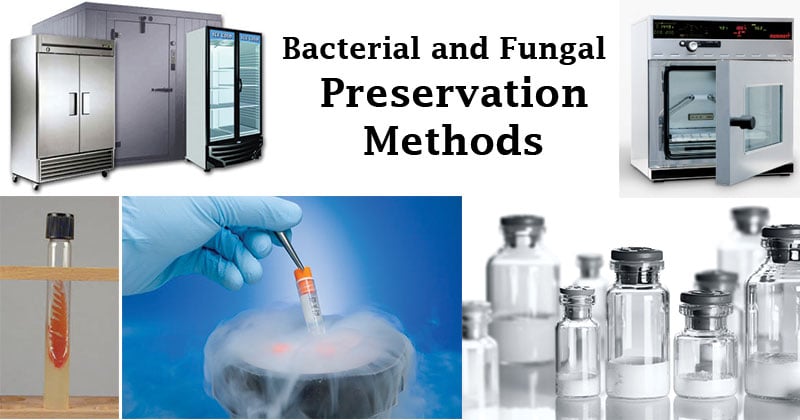- Biopreservation is the process of preserving the integrity and functionality of cells.
- Most bacteriological laboratories maintain stock cultures of microorganisms for educational, research, bioassay, industrial, or other purposes.
- A wide variety of techniques are available for the preservation of bacteria and it may be difficult to choose a method for a particular strain, which not only assures survival, but which also makes certain that the genotype and hence the unique characteristics do not change.
- The primary aim of culture preservation is to maintain the organism alive, uncontaminated, and without variation or mutation, that is, to preserve the culture in a condition that is as close as possible to the original isolate.

Interesting Science Videos
Agar Slant Cultures
- All microbiology laboratories preserve micro-organisms on agar slant.
- The agar slants are inoculated and incubated until good growth appears.
- They are then covered with sterile mineral oil to a depth of 1 cm above the tip of slant surface.
- The slants are incubated for 24hr or more and are then stored in a refrigerator.
- These cultures are periodically transferred to fresh media.
- Transfers are made by removing a loop full of the growth, touching the loop to the glass surface to drain off excess oil, inoculating a fresh medium and then preserving the initial stock culture.
- Time intervals at which the transfers are made which varies with the origin and condition of growth.
- This is a simple and most economical method of preserving bacteria and fungi where they remain viable for several years at room temperature.
Refrigeration
- Pure cultures can be successfully stored at 0-4°C either in refrigerators or in cold-rooms.
- This method is applied for short duration (2-3 weeks for bacteria and 3-4 months for fungi) because the metabolic activities of the microorganisms are greatly slowed down but not stopped.
- Thus their growth continues slowly, nutrients are utilized and waste products released in medium. This results in, finally, the death of the microbes after sometime.
Paraffin Method
- This is a simple and most economical method of maintaining pure cultures of bacteria and fungi.
- In this method, sterile liquid paraffin in poured over the slant (slope) of culture and stored upright at room temperature.
- The layer of paraffin ensures anaerobic conditions and prevents dehydration of the medium.
- This condition helps microorganisms or pure culture to remain in a dormant state and, therefore, the culture is preserved for several years.
Saline Suspension
- Sodium chloride in high concentration is frequently an inhibitor of bacterial growth.
- Bacteria are suspended in 1% salt solution (sublethal concentration in screw cap tubes to prevent evaporation).
- The tubes are stored at room temperature. Whenever needed the transfer is made on agar slant.
Cryopreservation
- Cryopreservation (i.e., freezing in liquid nitrogen at-196°C) helps survival of pure cultures for long storage times.
- In this method, the microorganisms of culture are rapidly frozen in liquid nitrogen at -196°C in the presence of stabilizing agents such as glycerol, that prevent the formation of ice crystals and promote cell survival.
Lyophilisation (Freeze-Drying)
- In this method, the culture is rapidly frozen at a very low temperature (around -70°C) and then dehydrated by vacuum.
- Under these conditions, the microbial cells are dehydrated and their metabolic activities are stopped; as a result, the microbes go into dormant state and retain viability for years.
- Lyophilized or freeze-dried pure cultures and then sealed and stored in the dark at 4°C in refrigerators.
- Freeze- drying method is the most frequently used technique by culture collection centres.
The Lyophilisation Process
- In this process the microbial suspension is placed in small vials.
- A thin film is frozen over the inside surface of the vial by rotating it in mixture of dry ice (solid carbon dioxide) and alcohol, or acetone at a temperature of −78oC .
- The vials are immediately connected to a high vacuum line. This dries the organism while still frozen.
- Finally, the ampules are sealed off in a vacuum with small flame.
- These cultures can be stored for several years at 40°C.
- This method is also employed for preservation of toxins, sera, enzymes and other biological material.
- To revive microbial cultures it is merely necessary to break open the vial aseptically, add a suitable stale medium, and after incubation make further transfers.
- The process permits the maintenance of longer number of culture without variation in characteristics of the culture and greatly reduces the danger of contamination.
Preservation at Very Low Temperature
- The organisms are suspended in nutrient broth containing 15% glycerol.
- The suspension is frozen and stored at -15°C to -30°C.
Preservation by Drying in Vacuum
- The organisms are dried over calcium chloride in the vacuum and are stored in the refrigerator.
References
- http://www.biologydiscussion.com/micro-biology/preserving-microbial-cultures-top-5-methods/17821
- http://www.biologydiscussion.com/microorganisms/culture-microorganisms/maintenance-and-preservation-of-pure-cultures-4-methods/55037
- http://www.asmscience.org/content/book/10.1128/9781555817497.chap473
- https://www.ncbi.nlm.nih.gov/pubmed/9629607
- gc11.ac.in/wp-content/uploads/2017/02/preservation-of-cultures.ppt

Thank you Sir .
It was so helpful. I myself being someone wanting to pursue phD currently a lecturer looking at your bio inspired me more. Thank you so much Sir.